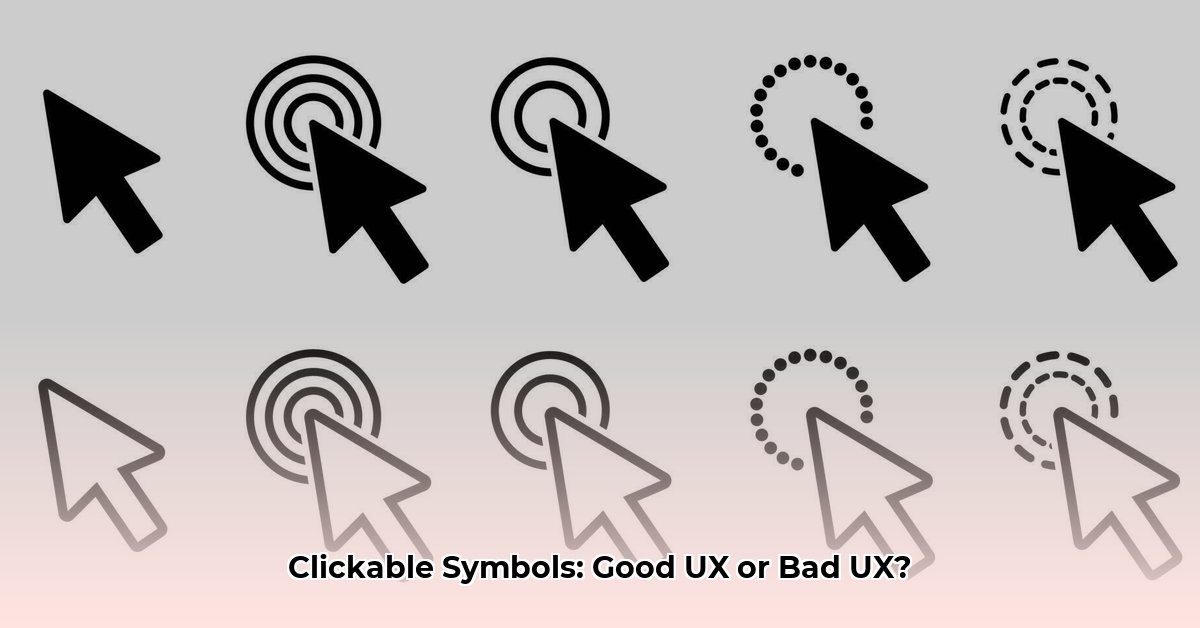Understanding the Clickable Symbol
A clickable symbol is any visual element on a digital interface that triggers an action when interacted with, whether by mouse click or touchscreen tap. These symbols, encompassing icons, buttons, and links, are fundamental to user experience (UX) design, acting as intuitive guides through the digital landscape. Imagine navigating a website without a clear “Add to Cart” button or playing a video without the familiar play icon – the importance of clickable symbols quickly becomes apparent. They transform static content into dynamic experiences, bridging the gap between user intention and digital action.
Types and Examples of Clickable Symbols
Clickable symbols manifest in various forms, each with its own distinct purpose:
-
Icons: Serving as visual shorthand, icons concisely represent actions, objects, or concepts. Examples include the ubiquitous save icon (often still a floppy disk!), the gear icon for settings, and the magnifying glass for search. Icons communicate information swiftly and efficiently, often without accompanying text.
-
Buttons: Buttons provide clear calls to action, typically featuring text labels like “Submit,” “Cancel,” “Learn More,” or “Buy Now.” They offer a distinct target for interaction, minimizing ambiguity about the resulting action.
-
Hyperlinks (Links): As the connectors of the web, hyperlinks enable navigation between different sections of a website or even to entirely new websites. Often underlined or visually differentiated from surrounding text, they are the pathways of online exploration.
-
Interactive Images: Images themselves can function as clickable symbols. Clicking a product image, for example, might enlarge the view or redirect to a detailed product page, adding a layer of interactivity beyond traditional text and button-based navigation. This can enhance user engagement and provide a more visually appealing experience.
Clickable Symbols in Web Development
The functionality of clickable symbols arises from the interplay of HTML, CSS, and JavaScript:
-
HTML (HyperText Markup Language): HTML forms the structural backbone, defining interactive elements using tags like
<button>for buttons and<a>for links. These tags lay the groundwork for subsequent styling and interactivity. -
CSS (Cascading Style Sheets): CSS dictates the visual presentation of clickable symbols, controlling aspects like color, font, size, and positioning. It ensures these elements align with the overall website design and aesthetic.
-
JavaScript: JavaScript empowers clickable symbols with dynamic behavior, defining the actions triggered by user interaction. Whether loading a new page, submitting a form, or initiating video playback, JavaScript brings interactivity to life.
Here’s a basic example of how HTML and CSS create a clickable icon:
<link rel="stylesheet" href="https://cdnjs.cloudflare.com/ajax/libs/font-awesome/4.7.0/css/font-awesome.min.css">
<a href="/home"><i class="fa fa-home"></i> Home</a>
.fa-home {
color: blue;
font-size: 2em; /* Example sizing */
}
.fa-home:hover {
color: darkblue; /* Example hover effect */
}
a { /* removes default link underline */
text-decoration: none;
}
This code snippet creates a clickable home icon using Font Awesome. Clicking the icon redirects the user to the “/home” URL. The CSS styles the icon blue and enlarges it. The hover effect darkens the blue color on mouseover.
“Clickable Symbol” Crossword Clue Solution
If the crossword clue is “Clickable Symbol,” the solution you’re likely seeking is “ICON” (especially for compact puzzles). This answer has appeared in puzzles like the New York Times Mini Crossword (November 14, 2024). However, it’s always prudent to cross-check with the specific puzzle source.
Icons and Usability: A Historical Perspective
Clickable symbols, particularly icons, have profoundly shaped human-computer interaction. Their emergence alongside graphical user interfaces (GUIs) revolutionized computing by replacing complex text commands with intuitive visual cues. The rise of touchscreens further solidified the importance of well-designed clickable symbols, particularly icons, for seamless navigation and interaction.
The history of icons is intertwined with the development of user-friendly interfaces. From early GUIs featuring simple icons to the sophisticated interactive elements in modern operating systems and applications, these visual cues have fundamentally changed how we interact with technology. Early icons often relied on metaphors to real-world objects, making their function immediately apparent. As interfaces became more complex, icon design evolved to incorporate abstract representations and conventions learned over time.
The Broader Context of Icons and Usability
Well-designed clickable symbols are essential for positive user experience:
-
Intuitiveness: They promote effortless navigation, enabling users to interact with interfaces instinctively without pausing to decipher functionality.
-
Efficiency: Clickable symbols expedite access to features, saving users time and effort.
-
Accessibility: Thoughtfully designed clickable symbols, combined with alternative text for screen readers enhance accessibility by ensuring users with disabilities can navigate and interact effectively.
The Future of Clickable Symbols
The future of clickable symbols will likely see ongoing evolution. Research into human-computer interaction constantly explores new design paradigms and emerging technologies. Areas of active investigation include the use of animation and micro-interactions, haptic feedback in touch interfaces, and the potential of 3D icons and augmented reality elements. There is also increasing emphasis on personalization and adaptive interfaces that adjust based on individual user behavior and preferences. While the specific forms may change, the core principles underlying effective clickable symbols will probably remain constant. Clarity, simplicity, and accessibility are likely to remain paramount as designers and developers continue to refine the ways we interact with digital environments. Some researchers suggest voice control and gesture-based interfaces may become more prevalent, further redefining the role of clickable symbols in the years to come.
Conclusion
Clickable symbols are more than mere visual elements; they are fundamental to the way we interact with the digital world. They empower users, enhance efficiency, and are crucial for accessibility. As technology advances, so too will the design and functionality of these ubiquitous elements, further shaping our digital experiences.
- How to Stop Apps From Running in the Background to Boost Your - December 1, 2025
- How To Move Apps On Your Droid For Better Organization - November 30, 2025
- How to Move Apps on Android for Better Organization - November 29, 2025










